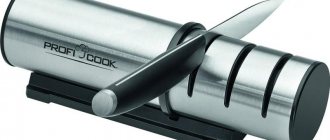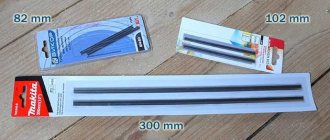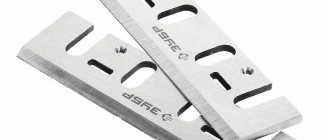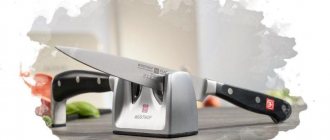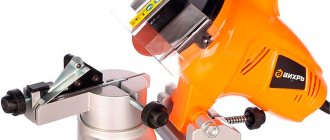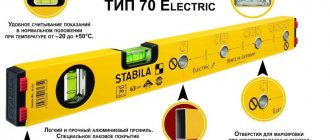- July 22, 2020
- Tools and equipment
- Andrey Sky
Almost any knife, especially for household use, requires regular restoration of the cutting edge. Due to constant mechanical impact, the tip becomes dull and deformed, which is why its performance is lost. Therefore, the sharpening process is a mandatory technological operation as part of the maintenance of this tool. This procedure can be performed with makeshift tools, but it is much more convenient to use special equipment like a sharpening machine. How to sharpen knives correctly on such a unit? Several aspects of the operation need to be taken into account at once - this applies to preparatory work and setting up equipment in compliance with safety rules.
When is it necessary to sharpen a knife?
If the tool is in good condition and fully ready for cutting operations, there is no point in adjusting its edge. On the contrary, performing this procedure may disrupt the initially correct edge geometry and reduce the quality of the cut.
But there are signs that clearly indicate that the use of an electric knife sharpener or other tool is required to restore the tip to working condition. For example, if small particles of metal are chipped off the edge. Some models of knives, depending on the material used, even pose a risk of injury in a dull state.
Another sign of a non-ideal state of the tip is the poor quality of the cut in principle. If the knife does not cut, but tears the product, it is necessary to correct it. The essence of the sharpening operation will be to restore the desired blade profile. In other words, the rounded edge of the tip must be given the shape of a cone.
How to sharpen a ceramic knife
Steel is not the only material for quality knives. Kitchen utensils with ceramic blades have become popular due to their high durability and sharpness. Its cutting part does not oxidize upon contact with any types of products. Can ceramic knives be sharpened? Yes, after 2-3 years of intensive use, the cutting edge requires restoration. The high strength of ceramics limits the range of turning tools.
What you can grow in your apartment or on your balcony that is healthy and tasty
As an advertising ploy, manufacturers offer a free sharpener along with the knife. This device cannot be used for its intended purpose; it is made of the same material as the blade, so it will not cope with sharpening. For ceramics, a sharpener with CBN or diamond coating is suitable. Electric sharpeners will help restore the sharpness of the blade. The advantages of the device include the following facts:
- The sharpening angle is adjusted automatically;
- processing is carried out on one or both sides, depending on the factory sharpening;
- edge sharpness at the level of professional chef's knives;
- The device is safe to use.
Electric sharpeners with diamond coating are an expensive purchase; if you have a limited budget, models with CBN parts are recommended. Before purchasing, check the documents and certificates of the product, this will protect you from counterfeiting.
The ceramic blade is sharpened by hand. For the procedure, a sharpening stone or grinding stone with diamond powder is used. An alternative available option is a tool with CBN chips.
How to choose a sharpening machine?
For household work, it is best to use electric models for household use. Today these are universal units with a desktop installation method that cope with the restoration of blades not only of knives, but also of axes, chisels, all kinds of cutters and scissors.
It is advisable to give preference to knife sharpening machines with an adjustable angle, which will initially improve the quality of the operation. Moreover, it is important to pay attention to the configuration of the working equipment. Firstly, much more sharpening capabilities will be provided by a machine that allows the use of an abrasive disc and tape. Secondly, it is more convenient to use a setup with two circles on different sides. The fact is that the process of point correction may require the use of abrasives with different degrees of grain size. To avoid wasting time on reinstalling them when moving from one circle to another, it makes sense to take care in advance about the possibility of installing two elements simultaneously from different sides.
Is it effective to sharpen knives with sandpaper or can it ruin the blade?
Almost any garage or shed has an electric sharpener (emery). Many home craftsmen use an angle grinder for these purposes - but this does not change the essence.
We suggest you read How to restore the color of a shirt
So, we have a fixed electric motor with an installed abrasive wheel. It's good if there is a speed controller. However, most of these devices have fixed speeds. A picture immediately appears with a spectacular sheaf of sparks flying out from under the blade of a knife.
Two or three movements - and the edge is sharp again. It is this method that is the biggest mistake. At high speed and strong pressure, the steel overheats, it “releases”, or even worse – annealing. It would seem that a well-sharpened knife will very soon become dull again.
The next question is how to press the blade? To the flat side of the abrasive or to the outer surface?
The correct angle of the knife blade when sharpening on sandpaper
Both methods are acceptable if the technology is followed:
- The abrasive should be fine-grained; you are not sharpening a hoe. Material – electrocorundum;
- Rotation speed no more than 150 rpm;
- The surface must be cooled. Plain water is enough. If it is not possible to continuously supply liquid to the contact point, it is necessary to install a bath under the circle. Of course, care must be taken to ensure that splashes do not enter the electric motor;
- And most importantly - at least a tool rest, or better yet, a device for controlling and fixing the angle of the blade.
Pay attention to the angle of the blade when sharpening
There are similar devices for working on a flat side. Basic principles of sharpening on an emery wheel:
- The rotation of the abrasive should be from the butt to the cutting edge;
- The knife moves across the circle in only one direction - from the handle to the tip. After each movement, the blade is inspected and time is given to cool down;
- The pressure of the blade to the sandpaper should be minimal;
- If the sharpening is double-sided, the angle of the fixing device does not change, we simply move the knife to the other side.
Despite all the disadvantages, sharpening a knife with emery also has its advantages. Only with the help of an abrasive wheel can one obtain a so-called concave lens, when the descent planes change their angle to a more acute one as they approach the working edge.
This technology is practically not used for sharpening professional tools. Real craftsmen who know the rules of sharpening knives do it only by hand. However, if you have no claims to a samurai sword, the method is quite suitable.
Features of professional sharpening machines
Such equipment has several technical and operational differences from household analogues. But it’s worth emphasizing right away that the cost of this machine can be 2-3 times higher than models for home use.
So, we are talking about more productive, functional and precise units that can confidently adjust the shape of an edge made of tool and high-speed steel. As a rule, professional electric knife sharpeners have a durable metal base, a balanced rotor, almost always the ability to install two wheels, and a powerful three-phase motor.
In terms of functionality, it is worth emphasizing the possibility of adjusting the reach, point-by-point adjustment to the dimensions of the tool being processed, and automatic wetting of the working equipment, which protects it from overheating.
Which knives are best not to sharpen yourself?
It is very convenient when the knives are always sharp and do not need to be sharpened. These are models with a self-sharpening function. There is a protective layer on top of the blade. It is made of metal. They're dumb. But very slowly and over many years.
There are some types of knives that you should not sharpen yourself.
Which knives do not need to be sharpened:
- Damascus steel - these knives should only be sharpened by a specialist who has experience sharpening such products.
- Bulat. A special type of steel does not dull for a long time. Over time it may lose its properties. Only a master should sharpen.
- Serrated coatings. If these products become dull, then no one can return them to their former sharpness. These models are not subsequently sharpened.
The best manufacturers of sharpening machines
In the budget segment, for simple sharpening tasks you can find good offers from domestic manufacturers. These are machines costing up to 3-4 thousand rubles. from brands such as “Vikhr”, “Kraton”, “Caliber”, etc.
The middle and most popular segment is represented by models with a price tag of approximately 5 to 10 thousand from Bosch, Metabo and Makita. According to reviews, one of the best knife sharpening machines in this group is the Bosch GBG 60-20 model. It has balanced characteristics and decent German workmanship.
Private craftsmen and industrial workers will be interested in professional models. This is a narrow, but technologically developing class of sharpening machines from companies such as Inforce and Proma in the BKL line.
Electric knife sharpeners
Modern electric sharpeners are a design with an electric motor, on the axis of which abrasive discs coated with diamond are located.
The components of the sharpener are placed in a closed housing with slots for the blades. There are models in which the angle of the blade is set automatically.
Electric sharpeners have the following advantages:
- compact dimensions;
- availability of sharpening and polishing modes;
- connectors for different types of knives and scissors;
- safety at work.
Before using the sharpener, you must read the instructions, which include:
- device description;
- work rules;
- sharpening direction;
- recommended implement angles.
To add sharpness, the blade must be inserted into the hole of a working sharpener and pulled towards you. The number of repetitions depends on the degree of edge wear (from 5 to 10). The blade is then polished.
The disadvantages of an electric sharpener include its relatively high price. It must be remembered that tools sharpened with this equipment quickly become dull.
Abrasive wheel selection options
This consumable material for a processing machine is available in a wide range. The sharpening wheel specifically for a knife should be designed for working with steel and the possibility of finishing correction.
The shape of the profile is fundamentally important for working with sharpening. In this case, equipment with a straight profile is used, which is optimal for straightening the blade.
The grit size will determine what type of finish a particular abrasive wheel can provide. For a sharpening machine used to correct a knife blade, almost all types of fractions can be used. Usually there are three ranges - from 400 microns, from 1000 microns and from 5000 microns. Accordingly, coarse, medium and fine sharpening is provided. Sometimes you can limit yourself to just finishing touches if the blade requires only minor editing.
The type of abrasive itself is equally important. Although knives are not overly demanding tools in terms of machining and dressing, today it is better to give preference to the more durable and efficient alumina blades. This material is hard and resistant to damage.
Sharpening tools
Proper sharpening of knives is the main condition for successful work in the kitchen, so the choice of sharpening tools must be approached with special care and thoroughness. The following types of such instruments are distinguished:
- Muscat. This item is very similar in appearance to a file; it has a round, elongated shaft and a comfortable handle. It makes it very easy to keep your knife in working condition. However, if the kitchen helper is very dull, then it will not be possible to sharpen it. For these purposes, craftsmen recommend using another sharpening object.
- Mechanical sharpener. The device is in great demand among housewives. You can sharpen a blade with it in the shortest possible time and without much effort. However, the quality of sharpening will not be the best, so the procedure will soon have to be repeated. The tool is only suitable for kitchen knives.
- Electric sharpener. It, unlike the mechanical version, copes with its task well. In addition to sharpening, the sharpener can also polish knives, scissors or screwdrivers. A significant drawback of the device is its high cost, ranging from 3 to 60 thousand rubles, depending on the power and speed of operation.
- Machine with abrasive wheel. It is intended for professional sharpening. As a rule, it is used in industrial organizations. This device hardens steel at a certain temperature. Failure to follow this rule can cause irreparable damage to the knife.
- A whetstone (stone) is the most effective way to sharpen a dull knife. Although this process is not the fastest and easiest, it is very entertaining. Experienced craftsmen recommend having two bars on hand: a fine-grained abrasive for grinding and a coarse-grained one for sharpening. There are four types of sharpening stones: diamond, ceramic, Japanese water and Arkansas.
How to check the grinding wheel?
Whatever wheel is used in the work, it must be carefully checked before performing the operation. The audit must begin with a visual inspection. The item should not have the slightest crack or even chip.
Next, a check is performed on the machine. For this procedure, it is better to use a professional knife sharpening machine, which provides more effective safety features and customization options. On it, in particular, it will be possible to check the abrasive wheel for runout. This defect is expressed in vibrations, when, upon external observation, the outer edge of the disk moves away from the center to the sides. If such a flaw occurs, then the abrasive will need to be corrected with a special diamond device.
Processing a blunt instrument on a machine
The industry produces various electric knife sharpeners.
The entire mechanism is located in the housing, which makes working on the machine completely safe. No effort or special skills are required, so any housewife can easily cope with this task.
An electric motor rotates an axis on which several abrasive wheels for various purposes are located. From rough to give the primary shape or restore the geometry of the blade, to polishing, which is used for final finishing.
Since the sandpaper has a fixed shape, the contact angle is set by guides that can be adjusted or simply changed depending on the type of tool.
To work, you need to know at what angle to sharpen your knife. To avoid mistakes, when purchasing, you should ask the seller what the parameters of the blade you are purchasing are, or take measurements on a new tool.
After setting the correct angle, we begin sharpening:
- If the cutting edge is very dull or has jagged edges, we first process it using coarse sandpaper. The knife moves with little effort from the handle to the tip. After each pass, we check the degree of sharpening to prevent excessive material removal. Then we move on to a fine-grained polishing pad;
- To restore the sharpness of a normal blade, it is enough to edit it on a polishing wheel;
Each machine comes with instructions that indicate the direction of sharpening, as well as the parameters of the sanding wheels and guides.
General sharpening technology
First of all, you need to consider the operation from the outside. It is usually performed in two stages.
Initially, a smooth edge of the chamfer is formed so that it is sharp and without external defects. We can say that this is a rough sharpening, during which the general geometry of a sharp blade is simulated without the previous roundness. At this stage, wheels with a large grain fraction can be used.
The second stage involves performing a much more important operation to restore the blade. How to properly sharpen knives on a sharpening machine as part of the finishing edit? Much will depend on the experience of the performer, but in any case, you should focus on the existing shape of the blade, which was modeled during rough processing. At this stage, small irregularities and burrs are usually removed that cannot be carefully removed with large-format abrasive.
Sharpening or straightening knives
Before returning the knife blade to its original state using an electric sharpener, it is necessary to determine what actions are required for this tool - sharpening or straightening. When using a blade, the tip is often damaged and deformed.
It forms:
- edge bend;
- chips;
- wavy surface.
Electric knife sharpener.
Removing defects on a grinding machine will require the use of different attachments and changing the rotation speed. Otherwise, you can cut off the excess layer of metal.
To avoid this, you must first straighten the tool using mechanical straightening using a tool in the form of a round file (musat). It has a special surface made of durable steel, ceramics or diamond chips. The device is suitable for removing the bend of the blade at the edge.
Experienced craftsmen sharpen blades on a sharpening machine at minimum speed.
The wave-shaped deformation is cut off completely. There is no other way to remove it. Chips should be removed in the same way. Then you need to start sharpening the tip.
Technique for sharpening knives on a machine
Now you can move on to the most important stage - direct work with the knife.
It is advisable to position the blade against the direction of movement of the disk, which will prevent the metal from crumbling at the edge and minimize the risk of the same burrs forming. The only disadvantage of this method of positioning the knife is the risk of cutting it into a circle, which will ruin the tip at one point and may well deform the entire knife. Therefore, at first, beginners can experiment with positioning the knife in the direction of the abrasive stroke.
At the editing stage, additional devices will be required for sharpening the knife on a sharpening machine. We are talking about a whetstone with the finest grain, which will allow you to carefully trim the edge in certain areas. The process of fine-grained sharpening on a machine should be performed with a minimum number of movements. There is a high risk of knocking down a chamfer, which will ruin the entire result. You need to act carefully and balanced - along the entire length of the blade. Both sides are processed in this way so that the shiny surface of the knife is equally visible.
Sharpening scissors
Sharpening of scissors must be done on a special sharpening machine. Sharpening blades using improvised materials (sandpaper, the edge of a glass, etc.) can temporarily improve the sharpness of scissors, but not for long. If you do not have the opportunity to have your scissors sharpened by a professional, you can try to sharpen them yourself on an abrasive stone. When sharpening you need to follow a few simple rules:
- The sharpening stone should be fine-grained.
- The blade is sharpened over the entire surface of the edge at the same time.
- The angle of the blade should match the factory edge.
- The movement of the blade along the stone should be from the screw to the tip.
- Scissors need to be sharpened disassembled.
When sharpening scissors, do not rush; patience will be your ally in this matter.
You can also watch the video on how to quickly sharpen scissors:
What is the correct knife sharpening angle?
The value is not universal, so you should focus on the specific type of knife and its application. It can be said that in the first stage of rough modeling of the geometry, some metal should be left for later removal for straightening purposes. When final sharpening knives, the angle is usually kept in the range from 7° to 45°. Moreover, average values of about 25° usually apply to kitchen tools, and the upper bar, up to 50°, applies to special models for tourist and hunting purposes.
7-step instructions for sharpening and finishing a kitchen knife
So, in sharpening a knife, one goal is to remove enough metal from the blade so that the cutting edge becomes sharp again. You need to start work with a coarse-grained abrasive and finish with a fine-grained one.
It is important to remember the following principles of sharpening knives:
- The most important thing is to choose the optimal sharpening angle and maintain it along the entire cutting edge while sliding along the block.
- Movements should be smooth, without pressure.
- All bars must be moistened with water, or better yet, with a soap solution: before sharpening (so that the blade glides better and metal dust does not clog the pores), during the process (to remove the resulting suspension) and at the end, to clean the bar.
And one more important tip - the first time it’s better to practice on a knife that you don’t mind ruining. Especially if your main knife is too good and expensive. Well, let's start practicing.
Step 1. Rinse the stone with water, and then run over it, say, with a sponge with a drop of dishwashing liquid.
Features of sharpening knives on a manual machine
Today there are many purely mechanical sharpening machines without an electric drive. They have a wide variety of design options and functionality. But when handling such a tool, it is important to consider several nuances. Firstly, a manual knife sharpener is usually mobile, which means that it will need to be well secured each time. This should be done on a workbench or other hard and stable table. Secondly, the sharpening process is performed with translational movements in only one direction. It should also be noted that with intensive use of manual sharpeners with a configuration of two V-directional abrasive stones, the knife will wear out much faster than when working with an electric machine.
Alternative sharpening methods
If your kitchen knife is a simple and inexpensive “hard worker” and/or you just don’t want to delve into the “knife culture”, then we recommend using an electric sharpener, a roller knife or a sharpening system for sharpening at home. What are their pros and cons?
- An electric sharpener sharpens knives perfectly and quickly, but even the highest quality models remove too much material from the blades, thereby shortening their service life. Another disadvantage of an electric sharpener is that a good device costs more than $200.
- A roller knife is an inexpensive and easy-to-use option. With its help, you can quickly sharpen a kitchen knife, but, unfortunately, the sharpness of the blade will not last long and the knife will deteriorate over time. The most trusted tool among roller scissors is the one from Fiskaris (pictured). Do not confuse a roller blade with a V-shaped blade. The latter is an option for the most frugal.
- Sharpening systems are good because they allow you to more accurately set and maintain an angle. There are different types of such sharpeners - with blade fixation (manufacturers DMT and Lanski) and with fixation of the stones themselves at a certain angle (Spyderco Triangle Sharpmaker). Separately, we can highlight a sharpening system in which you can select the desired angle and control the position of the knife - this is the Edge Pro Apex Knife Sharpening System. Each system has its own pros and cons. For example, on sharpeners with a fixed blade it is inconvenient to sharpen wide chef knives, but on a triangle from Spyderco the knives are straightened rather than sharpened, and you can only choose an angle of 30 or 40 degrees. However, for kitchen knives these are the angles that are needed, and using a triangle is very simple. A detailed review and operating instructions for the Spyderco sharpener can be seen in the following video.
What are the disadvantages of Apex Edge Pro? Perhaps this is just a high price - $245. However, to sharpen kitchen knives, you can buy a Chinese copy of this sharpener (for example, on Aliexpress).
There is another clever way to sharpen a knife at home - using a rough mark on the bottom of a ceramic mug or plate. The principle of operation is still the same - maintaining the angle, smooth movements, maintaining the cutting edge (cutting edge) perpendicular to the direction.
What should you know about sharpening stones?
Comprehensive maintenance of knives, even if you have a machine with abrasive wheels, is unlikely to do without a touchstone. This granular block will allow, if necessary, to correct the result obtained on the machine, as well as support the operation of the tool in the field, if necessary.
In addition, some electric units are fully equipped with such bars as consumables. How to sharpen knives correctly on this type of sharpening machine? The principle is somewhat similar to mechanical and electrical machines on circles. The only difference is that the operator does not need to make any special efforts. The main work will be done by the device itself. The maximum that will need to be done is to ensure external control of the process.
Of course, a lot will depend on the sharpening stone itself. They are ceramic, abrasive and natural. If we are not talking about using the product as part of an electric machine, then before work it is better to moisten it with a soap solution. This technique will improve glide and prevent intense spraying of small particles from metal and abrasive.
Grinding machine
Manual tools for sharpening knives can be replaced with electric ones. A grinding machine with an electric motor is equipped with an abrasive wheel. It can keep the blade sharp for a long time.
Professional sharpeners work with the machine at a low speed of rotation of the wheel - 200-300 revolutions. The danger for a beginner is overheating of the blade. When excessive pressure is applied to the home knife and the rotation speed is high, the metal heats up and then slowly cools down.
Tempering or annealing of the steel occurs. These processes reduce its hardness, the blade quickly dulls and crumbles.
Let's figure out how to properly sharpen knives on a grinding machine. The main condition for working is regular wetting of the blade with water. It is enough to place a container with cold liquid under the circle. The sharpening machine is equipped with two disks - one with a large abrasive for sharpening, the second for grinding. The sharpening angle is adjusted independently.
Safety requirements
Using a tool sharpening machine is a very reasonable and convenient way to solve the problem of dull blades. But we must not forget about safety. How to properly sharpen knives on a sharpening machine without harming your health? First of all, you can only work on proven and serviceable equipment, as well as on tested equipment, as already mentioned. During the operation, sudden manipulations and changes in the operating mode are excluded. All actions are performed smoothly and without jerking. Also, in the room where sharpening is carried out, there must be active ventilation. Small particles of abrasive and metal released during such operations must be removed immediately, as they pose a threat to the respiratory system.
